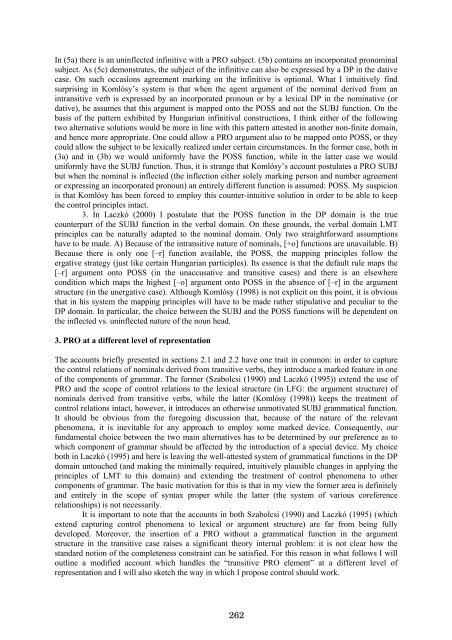Proceedings of the LFG 02 Conference National Technical - CSLI ...
Proceedings of the LFG 02 Conference National Technical - CSLI ...
Proceedings of the LFG 02 Conference National Technical - CSLI ...
You also want an ePaper? Increase the reach of your titles
YUMPU automatically turns print PDFs into web optimized ePapers that Google loves.
In (5a) <strong>the</strong>re is an uninflected infinitive with a PRO subject. (5b) contains an incorporated pronominal<br />
subject. As (5c) demonstrates, <strong>the</strong> subject <strong>of</strong> <strong>the</strong> infinitive can also be expressed by a DP in <strong>the</strong> dative<br />
case. On such occasions agreement marking on <strong>the</strong> infinitive is optional. What I intuitively find<br />
surprising in Komlósy’s system is that when <strong>the</strong> agent argument <strong>of</strong> <strong>the</strong> nominal derived from an<br />
intransitive verb is expressed by an incorporated pronoun or by a lexical DP in <strong>the</strong> nominative (or<br />
dative), he assumes that this argument is mapped onto <strong>the</strong> POSS and not <strong>the</strong> SUBJ function. On <strong>the</strong><br />
basis <strong>of</strong> <strong>the</strong> pattern exhibited by Hungarian infinitival constructions, I think ei<strong>the</strong>r <strong>of</strong> <strong>the</strong> following<br />
two alternative solutions would be more in line with this pattern attested in ano<strong>the</strong>r non-finite domain,<br />
and hence more appropriate. One could allow a PRO argument also to be mapped onto POSS, or <strong>the</strong>y<br />
could allow <strong>the</strong> subject to be lexically realized under certain circumstances. In <strong>the</strong> former case, both in<br />
(3a) and in (3b) we would uniformly have <strong>the</strong> POSS function, while in <strong>the</strong> latter case we would<br />
uniformly have <strong>the</strong> SUBJ function. Thus, it is strange that Komlósy’s account postulates a PRO SUBJ<br />
but when <strong>the</strong> nominal is inflected (<strong>the</strong> inflection ei<strong>the</strong>r solely marking person and number agreement<br />
or expressing an incorporated pronoun) an entirely different function is assumed: POSS. My suspicion<br />
is that Komlósy has been forced to employ this counter-intuitive solution in order to be able to keep<br />
<strong>the</strong> control principles intact.<br />
3. In Laczkó (2000) I postulate that <strong>the</strong> POSS function in <strong>the</strong> DP domain is <strong>the</strong> true<br />
counterpart <strong>of</strong> <strong>the</strong> SUBJ function in <strong>the</strong> verbal domain. On <strong>the</strong>se grounds, <strong>the</strong> verbal domain LMT<br />
principles can be naturally adapted to <strong>the</strong> nominal domain. Only two straightforward assumptions<br />
have to be made. A) Because <strong>of</strong> <strong>the</strong> intransitive nature <strong>of</strong> nominals, [+o] functions are unavailable. B)<br />
Because <strong>the</strong>re is only one [–r] function available, <strong>the</strong> POSS, <strong>the</strong> mapping principles follow <strong>the</strong><br />
ergative strategy (just like certain Hungarian participles). Its essence is that <strong>the</strong> default rule maps <strong>the</strong><br />
[–r] argument onto POSS (in <strong>the</strong> unaccusative and transitive cases) and <strong>the</strong>re is an elsewhere<br />
condition which maps <strong>the</strong> highest [–o] argument onto POSS in <strong>the</strong> absence <strong>of</strong> [–r] in <strong>the</strong> argument<br />
structure (in <strong>the</strong> unergative case). Although Komlósy (1998) is not explicit on this point, it is obvious<br />
that in his system <strong>the</strong> mapping principles will have to be made ra<strong>the</strong>r stipulative and peculiar to <strong>the</strong><br />
DP domain. In particular, <strong>the</strong> choice between <strong>the</strong> SUBJ and <strong>the</strong> POSS functions will be dependent on<br />
<strong>the</strong> inflected vs. uninflected nature <strong>of</strong> <strong>the</strong> noun head.<br />
3. PRO at a different level <strong>of</strong> representation<br />
The accounts briefly presented in sections 2.1 and 2.2 have one trait in common: in order to capture<br />
<strong>the</strong> control relations <strong>of</strong> nominals derived from transitive verbs, <strong>the</strong>y introduce a marked feature in one<br />
<strong>of</strong> <strong>the</strong> components <strong>of</strong> grammar. The former (Szabolcsi (1990) and Laczkó (1995)) extend <strong>the</strong> use <strong>of</strong><br />
PRO and <strong>the</strong> scope <strong>of</strong> control relations to <strong>the</strong> lexical structure (in <strong>LFG</strong>: <strong>the</strong> argument structure) <strong>of</strong><br />
nominals derived from transitive verbs, while <strong>the</strong> latter (Komlósy (1998)) keeps <strong>the</strong> treatment <strong>of</strong><br />
control relations intact, however, it introduces an o<strong>the</strong>rwise unmotivated SUBJ grammatical function.<br />
It should be obvious from <strong>the</strong> foregoing discussion that, because <strong>of</strong> <strong>the</strong> nature <strong>of</strong> <strong>the</strong> relevant<br />
phenomena, it is inevitable for any approach to employ some marked device. Consequently, our<br />
fundamental choice between <strong>the</strong> two main alternatives has to be determined by our preference as to<br />
which component <strong>of</strong> grammar should be affected by <strong>the</strong> introduction <strong>of</strong> a special device. My choice<br />
both in Laczkó (1995) and here is leaving <strong>the</strong> well-attested system <strong>of</strong> grammatical functions in <strong>the</strong> DP<br />
domain untouched (and making <strong>the</strong> minimally required, intuitively plausible changes in applying <strong>the</strong><br />
principles <strong>of</strong> LMT to this domain) and extending <strong>the</strong> treatment <strong>of</strong> control phenomena to o<strong>the</strong>r<br />
components <strong>of</strong> grammar. The basic motivation for this is that in my view <strong>the</strong> former area is definitely<br />
and entirely in <strong>the</strong> scope <strong>of</strong> syntax proper while <strong>the</strong> latter (<strong>the</strong> system <strong>of</strong> various coreference<br />
relationships) is not necessarily.<br />
It is important to note that <strong>the</strong> accounts in both Szabolcsi (1990) and Laczkó (1995) (which<br />
extend capturing control phenomena to lexical or argument structure) are far from being fully<br />
developed. Moreover, <strong>the</strong> insertion <strong>of</strong> a PRO without a grammatical function in <strong>the</strong> argument<br />
structure in <strong>the</strong> transitive case raises a significant <strong>the</strong>ory internal problem: it is not clear how <strong>the</strong><br />
standard notion <strong>of</strong> <strong>the</strong> completeness constraint can be satisfied. For this reason in what follows I will<br />
outline a modified account which handles <strong>the</strong> “transitive PRO element” at a different level <strong>of</strong><br />
representation and I will also sketch <strong>the</strong> way in which I propose control should work.<br />
262





